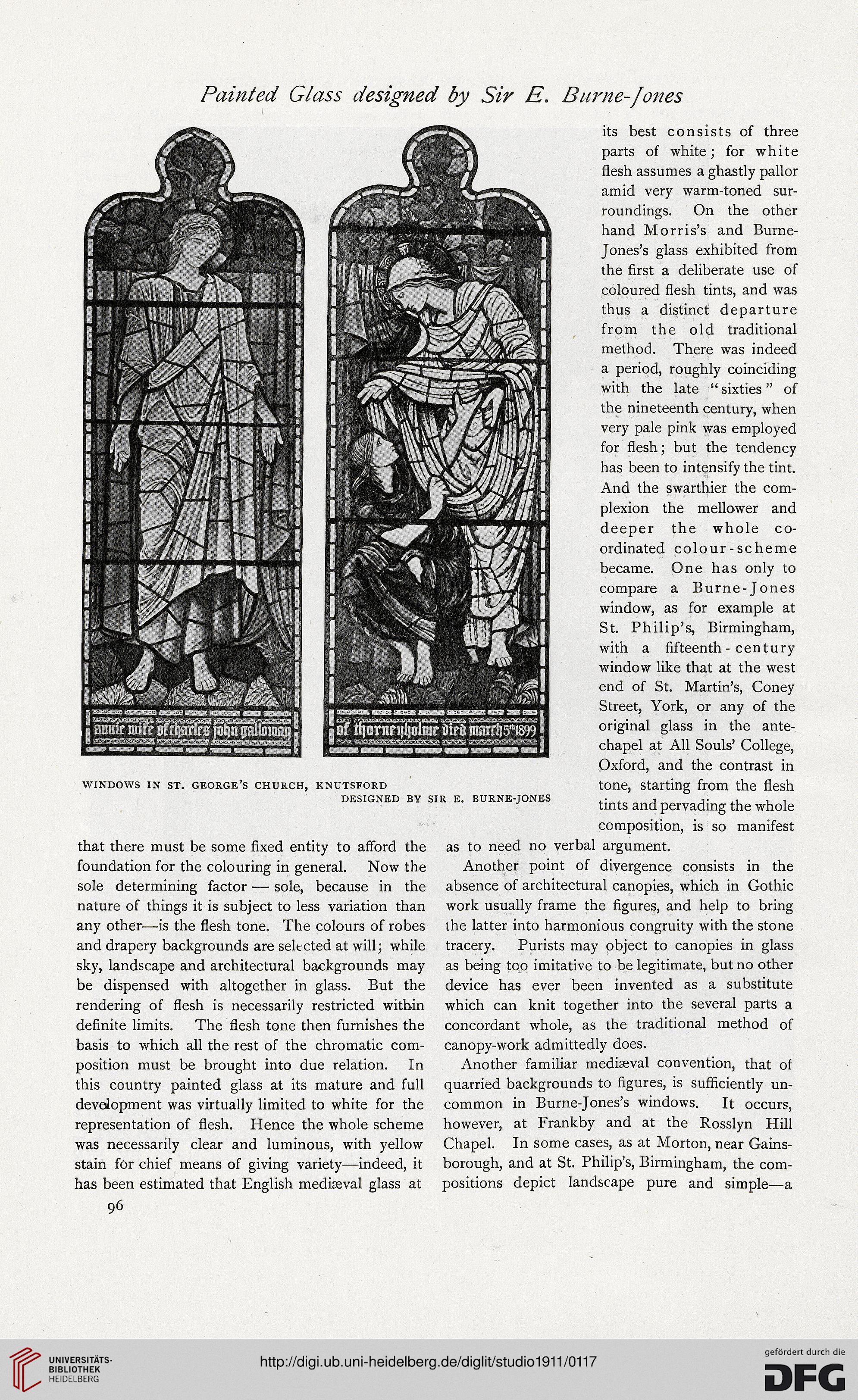Painted Glass designed by Sir E. Burne-Jones
that there must be some fixed entity to afford the
foundation for the colouring in general. Now the
sole determining factor — sole, because in the
nature of things it is subject to less variation than
any other—is the flesh tone. The colours of robes
and drapery backgrounds are seltcted at will; while
sky, landscape and architectural backgrounds may
be dispensed with altogether in glass. But the
rendering of flesh is necessarily restricted within
definite limits. The flesh tone then furnishes the
basis to which all the rest of the chromatic com-
position must be brought into due relation. In
this country painted glass at its mature and full
development was virtually limited to white for the
representation of flesh. Hence the whole scheme
was necessarily clear and luminous, with yellow
stain for chief means of giving variety—indeed, it
has been estimated that English mediaeval glass at
96
its best consists of three
parts of white; for white
flesh assumes a ghastly pallor
amid very warm-toned sur-
roundings. On the other
hand Morris’s and Burne-
Jones’s glass exhibited from
the first a deliberate use of
coloured flesh tints, and was
thus a distinct departure
from the old traditional
method. There was indeed
a period, roughly coinciding
with the late “ sixties ” of
the nineteenth century, when
very pale pink was employed
for flesh; but the tendency
has been to intensify the tint.
And the swarthier the com-
plexion the mellower and
deeper the whole co-
ordinated colour-scheme
became. One has only to
compare a Burne-Jones
window, as for example at
St. Philip’s, Birmingham,
with a fifteenth - century
window like that at the west
end of St. Martin’s, Coney
Street, York, or any of the
original glass in the ante-
chapel at All Souls’ College,
Oxford, and the contrast in
tone, starting from the flesh
tints and pervading the whole
composition, is so manifest
as to need no verbal argument.
Another point of divergence consists in the
absence of architectural canopies, which in Gothic
work usually frame the figures, and help to bring
the latter into harmonious congruity with the stone
tracery. Purists may object to canopies in glass
as being too imitative to be legitimate, but no other
device has ever been invented as a substitute
which can knit together into the several parts a
concordant whole, as the traditional method of
canopy-work admittedly does.
Another familiar mediaeval convention, that ol
quarried backgrounds to figures, is sufficiently un-
common in Burne-Jones’s windows. It occurs,
however, at Frankby and at the Rosslyn Hill
Chapel. In some cases, as at Morton, near Gains-
borough, and at St. Philip’s, Birmingham, the com-
positions depict landscape pure and simple—a
that there must be some fixed entity to afford the
foundation for the colouring in general. Now the
sole determining factor — sole, because in the
nature of things it is subject to less variation than
any other—is the flesh tone. The colours of robes
and drapery backgrounds are seltcted at will; while
sky, landscape and architectural backgrounds may
be dispensed with altogether in glass. But the
rendering of flesh is necessarily restricted within
definite limits. The flesh tone then furnishes the
basis to which all the rest of the chromatic com-
position must be brought into due relation. In
this country painted glass at its mature and full
development was virtually limited to white for the
representation of flesh. Hence the whole scheme
was necessarily clear and luminous, with yellow
stain for chief means of giving variety—indeed, it
has been estimated that English mediaeval glass at
96
its best consists of three
parts of white; for white
flesh assumes a ghastly pallor
amid very warm-toned sur-
roundings. On the other
hand Morris’s and Burne-
Jones’s glass exhibited from
the first a deliberate use of
coloured flesh tints, and was
thus a distinct departure
from the old traditional
method. There was indeed
a period, roughly coinciding
with the late “ sixties ” of
the nineteenth century, when
very pale pink was employed
for flesh; but the tendency
has been to intensify the tint.
And the swarthier the com-
plexion the mellower and
deeper the whole co-
ordinated colour-scheme
became. One has only to
compare a Burne-Jones
window, as for example at
St. Philip’s, Birmingham,
with a fifteenth - century
window like that at the west
end of St. Martin’s, Coney
Street, York, or any of the
original glass in the ante-
chapel at All Souls’ College,
Oxford, and the contrast in
tone, starting from the flesh
tints and pervading the whole
composition, is so manifest
as to need no verbal argument.
Another point of divergence consists in the
absence of architectural canopies, which in Gothic
work usually frame the figures, and help to bring
the latter into harmonious congruity with the stone
tracery. Purists may object to canopies in glass
as being too imitative to be legitimate, but no other
device has ever been invented as a substitute
which can knit together into the several parts a
concordant whole, as the traditional method of
canopy-work admittedly does.
Another familiar mediaeval convention, that ol
quarried backgrounds to figures, is sufficiently un-
common in Burne-Jones’s windows. It occurs,
however, at Frankby and at the Rosslyn Hill
Chapel. In some cases, as at Morton, near Gains-
borough, and at St. Philip’s, Birmingham, the com-
positions depict landscape pure and simple—a




